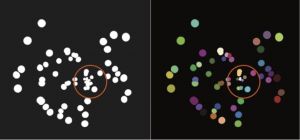Microorganisms, including bacteria, live in complex ecological communities consisting of multiple coexisting species, and understanding the mechanisms that maintain this biodiversity is a fundamental aspiration of ecology. Moreover, these communities play an increasingly important and promising role in biotechnology, for example to produce biofuels, create new foods or help crops grow better. However, not all micro-organisms coexist with each other, and learning how to engineer these communities to improve the services they provide is a major goal in biotechnology.
Until now, studies on microbial coexistence have largely focused on the isolated analysis of pairs of species, but it is not clear whether pairwise coexistence is necessary for coexistence to occur in a multiple community.
Álvaro Sánchez, a researcher at the CSIC's Centro Nacional de Biotecnología (CNB-CSIC), lead author of the paper, explains: "Different hypotheses have been put forward about the coexistence of several microbial species in a community. One of them suggested that each pair of species must also coexist with each other as an isolated pair. For example, A must coexist with B, B must coexist with C and C must coexist with A, if we want the trio A, B and C to coexist in a stable way".
For the CNB-CSIC researcher, this hypothesis, which has been gaining ground over the past few years, "is very enticing because, if it were generally correct, it offers a simple and practical way to predict coexistence in complex microbial communities. At the other extreme, it has also been proposed that multiple species can coexist through a mechanism equivalent to a game of rock-paper-scissors, where A excludes B, B excludes C, and C excludes A." "Under certain conditions, the mathematics tells us that this mechanism would allow all three species to coexist, even if none of the pairs we might form coexist with each other," he says.
A simple rule
To test pairwise coexistence, the authors decided to take apart twelve different microbial communities, containing between three and 10 coexisting species. They then performed competition experiments between all possible pairs of microorganisms and found that, "contrary to the first hypothesis, most of the pairs failed to coexist," says Djordje Bajic, researcher at Delft University of Technology. "In our analysis of the coexistence of numerous pairs of species, we found that competitive exclusion was the most common outcome, and that most species that coexist in a stable community cannot do so in isolated pairs," he adds.
In other words, the simple rule for predicting coexistence does not always work, indicating that, when it comes to coexistence, the whole is often more than the sum of its parts. The scientists found that, although most species do not survive on their own in competition with the more dominant species in their community, the presence of other members of the community facilitates their survival and prevents their extinction.
These results suggest that multispecific coexistence is a phenomenon that emerges from the combination of all species present in the habitat. "Despite this, our experiments also rule out the rock-paper-scissors mechanism. Competitive exclusion is highly hierarchical and the most abundant species tend to be also the most competitive when we grow them in pairs," says Sánchez.
Their results emphasizes that this important problem is not yet solved, highlighting the need to build new predictive tools and experimental systems that allow for rapid testing of new alternative hypotheses, which, according to the researchers, would enable a stronger dialog between theory and experiments
CY Chang, D Bajić, JC. Vila, S. Estrela, Á. Sanchez. Emergent coexistence in multispeciesmicrobial communities. Science. DOI https://www.science.org/doi/10.1126/science.adg0727






